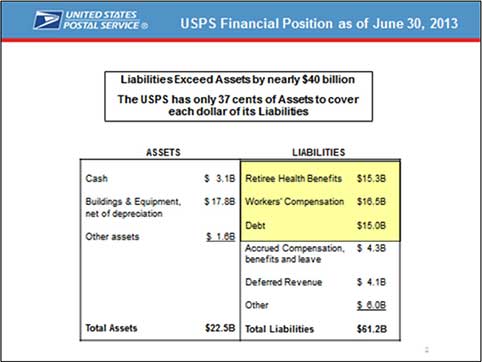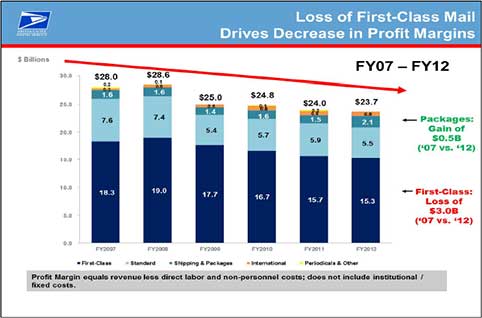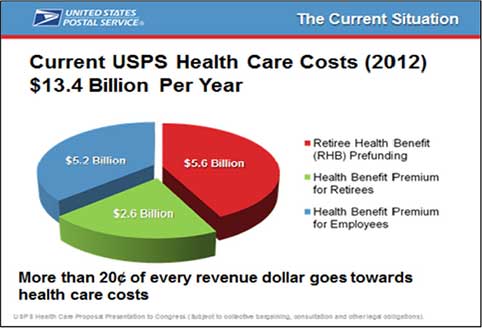09.19.2013

Analysis: USPS Financial Crisis
original article written by Net Advisor™
EXCERPT: This is a continuing series of the USPS financial disposition. Our first article in this series can be found here. We took a transparent look at the issues behind the USPS in this report.
WASHINGTON, DC. On Sept. 19, 2013 the USPS gave testimony (PDF, 16pps) before Congress over its financial status and issues its been experience for years.
[1] USPS is in Technical Bankruptcy
USPS admitted today that it has $62 Billion of liabilities and only $22 billion of assets (Report: page 1, PDF, 16pps).
[2] USPS Running Out of Cash – Fast
The United States Postal Service reached its maximum borrowing limit of $15 Billion from the U.S. Treasury. As of June 30, 2012, USPS also lost $5.2 Billion (Source: CNN). USPS has an annual estimated cash flow of $140 Billion, but lost $15.9 Billion in 2012 (Source: Bloomberg).
Despite cost cutting, USPS lost $1.3 Billion from October to December 2012. USPS expects to have “two and a half days of operating cash left at the end of its fiscal year Sept. 30, even assuming it defaults on a (another) $5.6 billion payment due to the U.S. Treasury for future retiree health-care costs” (Source: Bloomberg).
Keep in mind that other mail carriers such as FEDEX and UPS also have retirement and healthcare costs. Neither FEDEX or UPS are in financial turmoil.

[3] No Cash? No Problem: USPS Increasing Wages for Existing Employees Anyway
In a recent NALC-USPS arbitration award, there was a 2 year wage freeze where no Cost of Living Adjustments (COLAs) would be received in year one, and a deferral of COLAs in year two.
This included “modest wage increases in FY2014 through FY2016.” In exchange for higher wages for existing employees, lower level new hires will receive less pay (Source: 2011 USPS-NALC National Arbitration Agreement, p10 of 69 PDF / Link only) .
If you can’t afford to pay your employee’s healthcare costs, already maxed out your credit-lines with Congress, defaulted on current healthcare payments, and going to go bankrupt, you might as well spend what money you have and increase your salary?
MYTH: “The USPS has to pre-fund its healthcare for 75 years”
[4] The 75 Year Pre-Pay Healthcare Myth
There seems to be a lot of opinionated incorrect discussion that somehow the USPS has to ‘pre-fund 75 years’ worth of ‘healthcare costs in advance.’
The political progressive group Thinkprogress.org argued such, published a quotation but did not cite its source.
“…Congress passed the Postal Accountability and Enhancement Act of 2006 (PAEA). Under PAEA, USPS was forced to “prefund its future health care benefit payments to retirees for the next 75 years in an astonishing ten‐year time span…”
— Source: ThinkProgress.org said on 09-28-2011 (PDF)
We tried to figure out where their data came from. It is possible, thinkprogress meant to quote a 2011 talking points memo (page 1, PDF) from the National Association of Letter Carriers (NALC)?
First understand that the NALC is not the USPS, it is the national labor union of city delivery letter carriers employed by the United States Postal Service. NALC is part of the labor union, AFL-CIO.
NALC misconstrues the facts requiring USPS to fund their healthcare costs for the next “75 years” and even for “employees who have yet to be hired.”
We re-read the law and did various document searches and this is our findings.
FACT: The following words or whole number(s) don’t even appear in the 2006 Postal Accountability Act:
“seventy”
“seventy-five”
“seventyfive”
“75”
Next, we tried reverse engineering to look for the data that some claim that the USPS has to “pre-funded healthcare costs” for the next “75 years.”
We began when the law was enacted (2006) and just added 75 years (2006+75 = 2081). This gives us a date of 2081; and this date does not appear anywhere in the law either. In fact, there were no dates from 2057 to at-least the year 3000 written in the said law.
— Source: 2006 Postal Accountability Act, Public Law 109-435; 67pps PDF / Share Link
Where people get this ’75 year pre-pay healthcare’ idea is preposterous. If anyone can find it in the law, please point it out by commenting below this article, then Tweet me an FYI to examine the law.

[5] Liability Noted, but Not Accounted For
Here is the problem. USPS had been on a “paygo” system, meaning as people retired USPS would just add those monthly expenses to their books as they are due. USPS did not bother to set aside the billions in annual expenses it would have perpetually to cover healthcare costs for existing employees (Source: Bloomberg PDF).
The problem with this kind of system is, if (healthcare) costs go up and you never planned to save for these eventual expenses, this depletes existing cash flow from your business. And if your business is already losing billions a year, this means trouble.
The USPS and federal government knew the liability of these costs, reported such, but did not plan in advance to how they will pay for them. This is exactly how Medicare and most entitlements are run, which helps explains a good chunk of our now $17 Trillion current deficit.
[6] How Government Handles Debt
The Federal Government handles much of its current and future debt by just adding to it. The “Fiscal Cliff” problem was largely solved by just adding $4 Trillion to the future deficit. The USPS is not like the U.S. Treasury where money can just be printed.
USPS has to earn the money or borrow it. The funny thing is, no bank will loan money to the USPS. So Congress authorized loans to help the USPS, but when it came time for the USPS to repay the loans, USPS went into default.
The USPS just has to make adjustments and account for their healthcare costs.
[7] Official Accounting For USPS HealthCare Costs
By June 30, 2017 the USPS only has to make the CALCULATION, not the full payment of estimated healthcare costs or any surplus that they may have by September 30, 2056.
“Not later than June 30, 2017, the Office shall compute, and by June 30 of each succeeding year shall recompute, a schedule including a series of annual installments which provide for the liquidation of any liability or surplus by September 30, 2056, or within 15 years, whichever is later, of the net present value deter-mined under subparagraph (A), including interest at the rate used in that computation.”
— Source: 2006 Postal Accountability Act, Subsection § 8909.a. (B) Postal Service Retiree Health Benefit Fund, PDF page 55.
Notice the law said “annual installments,” not fund for the next 75 years. The amount of money the USPS has to set aside (pay the U.S. Treasury) to hold healthcare payments was calculated from 2007 to 2016 which is as follows:
$5.4 Billion due by September 30, 2007; (USPS Funded)
$5.6 Billion due by September 30, 2008; (USPS Funded)
$5.4 Billion due by September 30, 2009; (USPS Funded)
$5.5 Billion due by September 30, 2010; (USPS Funded)
$5.5 Billion due by September 30, 2011; (USPS Funded)
$5.6 Billion due by September 30, 2012; (USPS Defaulted)
$5.6 Billion due by September 30, 2013;
$5.7 Billion due by September 30, 2014;
$5.7 Billion due by September 30, 2015;
$5.8 Billion due by September 30, 2016;
— Schedule Source: 2006 Postal Accountability Act, Subsection § 8909.a. Postal Service Retiree Health Benefit Fund, PDF pages 55-56.
And there you have it. Of the estimated $140 Billion annual cash flow, the USPS has to set aside roughly 4.3% for healthcare costs.
[8] End of Saturday Delivery? Sort of.
USPS will have to make more cuts to stay afloat. It currently plans to stop Saturday mail delivery but this is for letters only. It will still deliver packages on Saturday. This doesn’t solve their problem at all.
“The financially struggling U.S. Postal Service announced Wednesday that it plans to stop delivering mail on Saturdays starting the week of Aug. 5 — but will continue delivering packages.”
— Source: Washington Post, 02-06-2013
USPS said by not delivering letters on Saturday will save them $2 Billion a year. How much could they save by not delivering packages Saturday except perhaps December holidays when mail traffic (and profit) is at its best?
Raising wages in times of financial trouble suggests serious inefficiencies still exist within USPS, and their cost cutting plans don’t meet their financial obligations.
[9] Quick, Blame Bush for Postal Accountability Act of 2006?
For those still looking for a scapegoat looking to figure out who to blame for the Postal Accountability Act of 2006 we did the research for you.
Yes, President George Bush did sign the 2006 postal act, however he did not legislate it. In 2006, the Democrats controlled BOTH houses of Congress.
United States House of Representatives:
All 435 seats in the United States House of Representatives were up for election.
| Party | Seats | Popular vote | ||||||
|---|---|---|---|---|---|---|---|---|
| 2004 | 2006 | +/− | % | Vote | % | +/− | ||
| Democratic Party | 202 | 233 | +31 | 53.6% | 42,338,795 | 52.3% | +5.5% | |
| Republican Party | 232 | 202 | −30 | 46.4% | 35,857,334 | 44.3% | −5.1% | |
| Libertarian Party | − | − | − | − | 656,764 | 0.8% | −0.1% | |
| Independent | 1 | 0 | −1 | – | 417,895 | 0.5% | −0.1% | |
| Green Party | − | − | − | − | 234,939 | 0.3% | – | |
| Independence Party | − | − | − | − | 85,815 | 0.1% | -0.1% | |
| Constitution Party | − | − | − | − | 68,031 | 0.1% | – | |
| Other parties | − | − | − | − | 1,315,964 | 1.6% | −0.1% | |
| Totals | 435 | 435 | − | 100.0% | 80,975,537 | 100.0% | − | |
Result: Democrats controlled 53.6% majority of the House [Chart: wikipedia.org. Additional source: CNN (PDF)].
United States Senate:
Result: Democrats controlled 53.16% majority of the Senate with 2 “Independents joined with the Democrats in their caucus” [Chart: wikipedia.org. Additional Source: NBC News (PDF)].
So, yes, President Bush signed the bill what the Democrats had demanded of USPS. In 2009, all of this could have changed again when the Democrats retained both Houses in Congress and the Whitehouse. But why would you change legislation that you already won?
__________________________________________________________________________
Graphics Credit: USPS; Chart: wikipedia.org.
original content copyright © 2013 NetAdvisor.org® All Rights Reserved.
NetAdvisor.org® is a non-profit organization providing public education and analysis primarily on the U.S. financial markets, personal finance and analysis with a transparent look into U.S. public policy. We also perform and report on financial investigations to help protect the public interest. Read More.
__________________________________________________________________________

